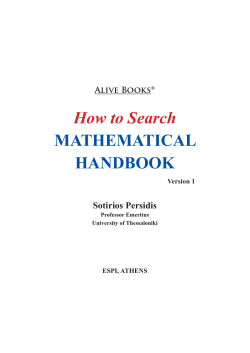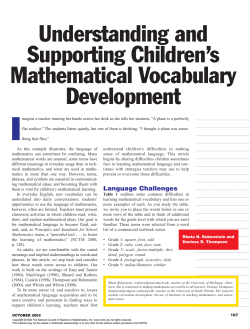
Grade 3 Unit Rubric: Patterns in Number and Geometry Name
Name Date Grade 3 Master 10.1 Unit Rubric: Patterns in Number and Geometry Level 1 Level 2 Level 3 Level 4 Thinking • uses planning and processing skills (e.g., using manipulatives, making a model, making a table, using a grid, using a calculator or computer) to solve problems involving: – geometric patterns – number patterns uses planning and processing skills to solve geometric and number problems with limited effectiveness uses planning and processing skills to solve geometric and number problems with some effectiveness uses planning and processing skills to solve geometric and number problems with considerable effectiveness uses planning and processing skills to solve geometric and number problems with a high degree of effectiveness demonstrates limited understanding of the concepts: – patterning results from repetition – growing and repeating patterns and pattern rules – repeated operations in patterns or multiple changes to attributes – relationships between and among patterns demonstrates some understanding of the concepts: – patterning results from repetition – growing and repeating patterns and pattern rules – repeated operations in patterns or multiple changes to attributes – relationships between and among patterns demonstrates considerable understanding of the concepts: – patterning results from repetition – growing and repeating patterns and pattern rules – repeated operations in patterns or multiple changes to attributes – relationships between and among patterns demonstrates thorough understanding of the concepts: – patterning results from repetition – growing and repeating patterns and pattern rules – repeated operations in patterns or multiple changes to attributes – relationships between and among patterns applies knowledge and skills with limited effectiveness when: – identifying and extending patterns – creating and recording patterns – describing patterns and pattern rules – showing patterns in tables and grids applies knowledge and skills with some effectiveness when: – identifying and extending patterns – creating and recording patterns – describing patterns and pattern rules – showing patterns in tables and grids applies knowledge and skills with considerable effectiveness when: – identifying and extending patterns – creating and recording patterns – describing patterns and pattern rules – showing patterns in tables and grids applies knowledge and skills with a high degree of effectiveness when: – identifying and extending patterns – creating and recording patterns – describing patterns and pattern rules – showing patterns in tables and grids uses mathematical conventions, vocabulary, and terminology with limited effectiveness when explaining reasoning and procedures uses mathematical conventions, vocabulary, and terminology with some effectiveness when explaining reasoning and procedures uses mathematical conventions, vocabulary, and terminology with considerable effectiveness when explaining reasoning and procedures uses mathematical conventions, vocabulary, and terminology with a high degree of effectiveness when explaining reasoning and procedures expresses and organizes mathematical thinking and work with limited effectiveness expresses and organizes mathematical thinking and work with some effectiveness expresses and organizes mathematical thinking and work with considerable effectiveness expresses and organizes mathematical thinking and work with a high degree of effectiveness Knowledge and Understanding • demonstrates understanding of the following concepts: – patterning results from repetition – growing and repeating patterns and pattern rules – patterns in which operations are repeated or multiple changes are made to attributes – relationships between and among patterns Application • applies knowledge and skills effectively to: – identify, extend, create, and record different types of patterns – describe patterns and pattern rules – show patterns in tables and grids Communication • uses mathematical conventions, vocabulary, and terminology (e.g., core, pattern rule, growing/ repeating pattern) effectively when explaining reasoning and procedures • expresses and organizes mathematical thinking and work effectively This page may have been modified from its original. 35 Copyright © 2007 Pearson Education Canada Name Date Grade 3 Master 10.2 Ongoing Observations: Patterns in Number and Geometry The behaviours described under each heading are examples; they are not intended to be an exhaustive list of all that might be observed. More detailed descriptions are provided in each lesson under Assessment for Learning. STUDENT ACHIEVEMENT: Patterns in Number and Geometry Student Thinking Knowledge and Understanding Application Communication § Uses critical/creative thinking processes to create and solve problems involving patterns § Demonstrates understanding of concepts when identifying, creating, and extending a pattern § Applies knowledge and skills related to patterns § Uses a table to display a number pattern § Uses conventions, vocabulary, and terminology effectively to describe patterns and explain reasoning and procedures Level 1 – limited; Level 2 – some/somewhat; Level 3 – considerable effectiveness; Level 4 – high degree of effectiveness 36 This page may have been modified from its original. Copyright © 2007 Pearson Education Canada Name Date Grade 3 Master 10.3 Performance Assessment Rubric: Indoor Recess! Level 1 Level 2 Level 3 Level 4 Thinking • uses critical/creative thinking processes to: – create a repeating pattern with at least 2 attributes changing – make a growing pattern – design an activity for indoor recess using a pattern on a grid chooses and carries out limited strategies to: – create the patterns and design the activity; may be only partially successful uses critical/creative thinking processes with some effectiveness to: – create the patterns and design the activity; may be relatively simple or have some flaws uses critical/creative thinking processes with considerable effectiveness to: – create the patterns and design the activity successfully uses critical/creative thinking processes with a high degree of effectiveness to: – create the patterns and design the activity successfully provides partial explanations that show very limited understanding of patterning and attributes provides appropriate but incomplete explanations of the patterns that show limited understanding of patterning and attributes provides an appropriate explanation of the patterns that shows understanding of patterning and attributes provides an appropriate and complete explanation that shows indepth understanding of patterning and attributes makes omissions or major errors in recording patterns records patterns with omissions or several minor errors records patterns with few minor errors records patterns with no errors or omissions • uses mathematical terminology correctly (e.g., repeat, pattern rule, core, attribute) uses few appropriate mathematical terms uses some appropriate mathematical terms uses appropriate mathematical terms uses a range of appropriate mathematical terminology clearly and precisely • explains the patterns and activity clearly explains the patterns and activity unclearly and imprecisely explains the patterns and activity with some clarity explains the patterns and activity clearly and precisely explains the patterns and activity clearly and confidently Knowledge and Understanding • shows understanding of patterning by describing and explaining the patterns Application • accurately follows patterning rules they have devised to record: – a repeating pattern with 2 attributes changing – a growing pattern, and its extension – a pattern on a grid Communication This page may have been modified from its original. 37 Copyright © 2007 Pearson Education Canada Name Date Grade 3 Master 10.4 Unit Summary: Patterns in Number and Geometry Review assessment records to determine the most consistent achievement levels for the assessments conducted. Some cells may be blank. Overall achievement levels may be recorded in each row, rather than identifying levels for each achievement category. Most Consistent Level of Achievement* Strand: Patterning and Algebra Thinking Knowledge and Application Understanding Ongoing Observations Strategies Toolkit (Lesson 4) Work samples or portfolios; conferences Show What You Know Unit Test Unit Problem Indoor Recess! Achievement Level for reporting *Use Ontario Achievement Levels R, 1, 2, 3, 4. SelfAssessment: Comments: (Strengths, Needs, Next Steps) 38 This page may have been modified from its original. Copyright © 2007 Pearson Education Canada Communication Overall Name Date Grade 3 Master 10.5 To Parents and Adults at Home … Your child’s class is starting a mathematics unit on patterns in number and geometry. Patterns occur in the world around us, as they do in mathematics. Recognizing and understanding patterns are key steps in developing a higher level of mathematical thinking. In this unit, your child will: · Identify, create, and extend number patterns. · Find pattern rules. · Display number patterns in tables. · Identify, create, and extend growing patterns. · Create patterns by changing attributes. · Identify, create, and extend patterns on grids. · Use a computer to explore patterns. Number and geometry patterns can be found outside the classroom. Encourage your child to look for patterns around the home, and talk about them. Here are some suggestions for activities that you can do at home: · Look for patterns in your family’s activities marked on the calendar at home. · Look for repeating patterns in the schedule for television shows. · Use coins to make patterns in which 2 or 3 attributes change. · Look for patterns in fabric and wallpaper. · Find examples of patterns on a grid, such as in bathroom tiles and on game boards. This page may have been modified from its original. 39 Copyright © 2007 Pearson Education Canada Name Date Grade 3 Master 10.6 Additional Activity 1: Roll and Go! Work with a partner. You will need a number cube. How to play: Ø Each player chooses a number between 5 and 10. This is the start of a number pattern. Ø Each player rolls the number cube. This is the number that is added each time. Ø Write the next 5 numbers in your pattern. Ø Trade patterns with your partner. Find your partner’s pattern rule. Check to make sure all numbers fit. Take It Further: Each player chooses a number between 31 and 40. This is the sixth number in a number pattern. Each player rolls the number cube. This is the number that was added each time. Work backward to find the first 5 numbers in your pattern. Trade patterns and find your partner’s pattern rule. 40 This page may have been modified from its original. Copyright © 2007 Pearson Education Canada
© Copyright 2025





















